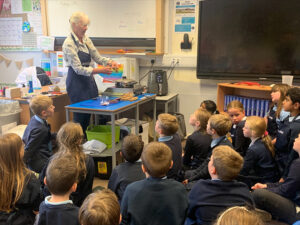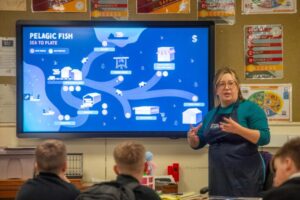Blogs and News from Partners
Surveying in the Clyde 1
Marine Directorate Image Bank posted a photo:
Photo by Guillaume Hermann
Marine Directorate
Crown Copyright 2024
Surveying in the Clyde. Ailsa Craig
Marine Directorate Image Bank posted a photo:
Photo by Guillaume Hermann
Marine Directorate
Crown Copyright 2024
Surveying in the Clyde 2
Marine Directorate Image Bank posted a photo:
Photo by Guillaume Hermann
Marine Directorate
Crown Copyright 2024
Surveying in the Clyde 3
Marine Directorate Image Bank posted a photo:
Photo by Guillaume Hermann
Marine Directorate
Crown Copyright 2024
Surveying in the Clyde 4
Marine Directorate Image Bank posted a photo:
Photo by Guillaume Hermann
Marine Directorate
Crown Copyright 2024
Surveying in the Clyde. Skate egg
Marine Directorate Image Bank posted a photo:
Photo by Guillaume Hermann
Marine Directorate
Crown Copyright 2024
Surveying in the Clyde 5
Marine Directorate Image Bank posted a photo:
Photo by Guillaume Hermann
Marine Directorate
Crown Copyright 2024
Surveying in the Clyde 6
Marine Directorate Image Bank posted a photo:
Photo by Guillaume Hermann
Marine Directorate
Crown Copyright 2024
Surveying in the Clyde. Ailsa Craig from the MRV Scotia
Marine Directorate Image Bank posted a photo:
Photo by Guillaume Hermann
Marine Directorate
Crown Copyright 2024
Bilateral agreement with Norway brings additional fishing opportunities
The agreement includes reciprocal access for demersal stocks such as haddock, cod and plaice, which will allow Scottish fishers to catch up to 30,000 tonnes of their existing North Sea quotas in Norwegian waters. Access has also been agreed for North Sea herring in UK waters, and Atlanto-Scandian herring in Norwegian waters, up to a cap of 20,000 tonnes. Exchanges of quotas have also been agreed for 2025.
The arrangements for 2025 mirror those from last year, where the whitefish agreement of 30,000 tonnes gave over £17m worth of access opportunities to UK vessels in Norwegian waters.
Discussions with the Faroe Islands on further exchanges of opportunities are ongoing.
The post Bilateral agreement with Norway brings additional fishing opportunities appeared first on Marine.
Agreement on 2025 fish opportunities reached between UK and EU
The UK-EU bilateral negotiations to set Total Allowable Catches (TACs) for over 80 jointly managed stocks, including those in the North Sea and West of Scotland, have now concluded with an agreement.
The value of the UK-EU bilateral agreement to Scotland is estimated to be more than £219 million, representing an increase of £25 million compared to 2024.
The number of TACs for key stocks within Scottish sea basins, which were set at or below Maximum Sustainable Yield (MSY) and/or headline advice, has remained the same as in 2024.
TACs have been set at sustainable levels, taking into account scientific advice from the International Council for the Exploration of the Sea (ICES), socioeconomic factors and, where appropriate, TAC constraints to mitigate large increases and decreases in the scientific advice, which could negatively impact the industry and markets.
Among the stocks covered by this agreement are North Sea and West of Scotland nephrops, monkfish and hake as well as Rockall haddock and cod, and West of Scotland whiting, cod, and haddock, which are of key importance to the Scottish industry.
The parties concluded these negotiations in a positive spirit, and a number of commitments were made ahead of 2025, which they will continue to progress through the UK-EU Specialised Committee on Fisheries.
The UK-EU bilateral written record can be viewed here. Allocations of quotas to individual producer organisations and vessels will be made in the new year.
The post Agreement on 2025 fish opportunities reached between UK and EU appeared first on Marine.
Agreement on 2025 fishing opportunities reached between UK, EU and Norway
The UK-EU-Norway trilateral negotiations to set Total Allowable Catches (TACs) for six shared North Sea stocks have now concluded.
The agreement sees TACs for all six of the jointly managed stocks set at levels consistent with the Maximum Sustainable Yield (MSY) approach. The resulting quotas are worth an estimated value of more than £200 million to Scotland. Parties also discussed a number of areas of joint working, which will continue with further close cooperation during 2025.
The catch limit for Northern Shelf cod has been agreed at a level reflecting the headline advice for the southern substock, and MSY scenarios for the two northern substocks. This will reduce fishing pressure. It is forecast to result in increases in the spawning stock biomass of all three substocks, whilst not disproportionately impacting those vessels fishing the relatively healthy northern substocks.
2025 TACs for the stocks have been agreed as follows. Percentage change from 2024 is shown in brackets:
- North Sea cod: 19,910 tonnes (-20.04%)
- North Sea haddock: 95,862 tonnes (-5.48%)
- North Sea whiting: 111,861 tonnes (+45.85%)
- North Sea saithe: 71,638 tonnes (+7.12%)
- North Sea plaice: 155,755 tonnes (+14.18%)
- North Sea herring (A fleet): 388,542 tonnes (-23.86%)
Commitments were made in the agreed record to progress work in 2025 on a number of areas of joint working, including the development of a long term management strategy for saithe, management of cod and herring, and monitoring, control and surveillance.
Additional bilateral consultations with coastal state partners are ongoing.
Allocations of quotas to individual producer organisations and vessels will be made in the new year.
The post Agreement on 2025 fishing opportunities reached between UK, EU and Norway appeared first on Marine.
Fishing Vessel Fraserburgh Harbour
Marine Directorate Image Bank posted a photo:
Photo by Chloe Fraser
Crown Copyright Marine Directorate 2024
Fishing Vessel in Fraserburgh Harbour
Marine Directorate Image Bank posted a photo:
Photo by Chloe Fraser
Crown Copyright Marine Directorate 2024
Stonehaven bay taken from MRV Temora whilst on a sampling trip
Marine Directorate Image Bank posted a photo:
Photo by Pablo Diaz
Crown Copyright 2024
Marine Directorate
the sun emerging on Stonehaven bay taken from MRV Temora whilst on a sampling trip
Marine Directorate Image Bank posted a photo:
Photo by Pablo Diaz
Crown Copyright 2024
Marine Directorate
Highlights from the MASTS Annual Science Meeting 2024
Marine Directorate scientists recently attended the MASTS (Marine Alliance for Science and Technology for Scotland) Annual Science Meeting, where they explored critical marine science topics like blue carbon, sustainable marine resources, and marine ecosystem health. This gathering emphasized the importance of innovative research in addressing marine sustainability and climate change challenges.
Workshops Towards Shaping Our Perspectives
Marine Directorate colleagues participated in three significant workshops that provided insights into some of the most pressing issues in marine science today:
- Workshops Towards Shaping Our PerspectivesBlue Carbon Knowledge Gaps: This session focused on improving data for blue carbon ecosystems, essential in carbon sequestration and climate mitigation.
- Sea Lice Monitoring Innovations: Participants discussed advanced tools for sea lice detection, vital for managing populations and protecting wild salmon stocks.
- Sustainable Marine Resource Management: Strategies and policies for ecological stewardship were examined to balance resource use with marine ecosystem health.
These workshops provided actionable insights that our team plans to incorporate into future policy and marine management initiatives.
Showcasing Our Expertise
Our colleagues shared their knowledge through several key presentations:
- Prof. Mark Inall presented on the role of Chief Scientific Advisor for Scotland’s Marine Directorate, emphasizing science’s influence on policy.
- Meadhbh Moriarty discussed using ensemble modelling to reduce uncertainty in sea lice dispersal patterns, a critical aspect of effective sea lice management.
- William R. Macdonald highlighted the broader ecological impacts of offshore wind farms on stratified shelf seas.
- Alexander Murray introduced the “Knowledge Strength” approach for refining policy advice, particularly in salmon lice dispersal.
- The meeting concluded with Bee Berx providing insights into ocean warming in Scottish waters, examining the effects of temperature changes on marine ecosystems.
Representatives from other directorates, such as the Offshore Wind Directorate and the Directorate for Culture and External Affairs, presented updates on Scotland’s marine energy research and Arctic connections.
In addition to these talks, Susanna Quer from the Renewable and Ecology Group presented an e-poster on Comparative Effects of the Processing Power of C-PODs and F-PODs on the Detection of Porpoises and Dolphins. This research investigates the effectiveness of two different passive acoustic monitoring devices in detecting cetaceans, a key component in monitoring marine biodiversity and informing conservation efforts.
Innovative Marine Research and Future Directions
We extend our gratitude to MASTS for hosting such an impactful event and to all the attendees for fostering a collaborative and forward-thinking environment. Our colleagues look forward to applying these insights and furthering our commitment to sustainable marine management in Scotland.
The post Highlights from the MASTS Annual Science Meeting 2024 appeared first on Marine.
Marine Fund Scotland helps serve up ‘Seafood in Schools’
Marine Fund Scotland has awarded over £55m, since 2021, to support projects that contribute to an innovative and sustainable marine economy, support coastal communities, and contribute to Scotland’s net zero ambitions.
In 2022 Seafood Scotland identified a gap in the education system for children to learn about the seafood sector. They wanted to raise awareness of the health benefits of eating fish, how sustainable it is as a food group and how fish can provide affordable protein for family meals.
After applying for and receiving £47,500 of MFS funding they launched an initial Seafood in Schools pilot programme during 2023-2024. This took place across primary and secondary schools with a series of workshops to educate and promote seafood to school age children.
Each programme was supported by suppliers within the seafood sector – providing products to be used within the workshops and as part of take-home packs for the primary school pupils to encourage them to cook fish at home.
The first year of the programme saw:
- Sixteen participating primary schools, reaching over 800 pupils between P4 and P6.
- Two participating secondary schools, reaching over 500 pupils in S2
- 100% positive feedback from teachers and head teachers on the workshops
- Positive engagement from industry supporting programme with product for the workshops.
Donna Fordyce, CEO of Seafood Scotland, said: “Following the successful pilot scheme and delivery of the primary schools programme, Marine Fund Scotland provided funding to support the development and roll out of pilot workshops across secondary schools to help extend the Seafood in Schools initiative.
“Engaging with school children and their influencers is vital for our sector. They learn how tasty our seafood is, and more about its nutritional value; that it’s versatile and economical to cook, and how vital and varied this sector is in terms of the species you can find around Scotland.
“This is important on so many levels: not only to ensure young people are eating seafood, but also – at a time when we’re seeing huge skills shortages across the industry – it’s imperative that we educate young people on the career opportunities available to them within the seafood sector.
“We are grateful to the Scottish seafood sector for supporting this initiative and supplying free products for us to use in schools, helping us to inspire the younger generation.
“Following these workshops, we have had funding confirmation for this financial year. This will allow us to expand the secondary school workshops into more areas, helping us encourage school leavers to find work in the sector and continue to build on our vital industry.”
Going Forward
The second Marine Fund Scotland award of £50,000 will allow Seafood Scotland to build on the success of the workshops and evolve the 2024-2025 programme of activity. The 2024-25 strategy focuses on reaching more pupils by creating tools to help teachers spread the word. By creating an accessible team of experts and useful resources for teachers, the Seafood in Schools programme will have far reaching benefits for the seafood industry.
The post Marine Fund Scotland helps serve up ‘Seafood in Schools’ appeared first on Marine.
Outcome of Coastal States consultations on mackerel, blue whiting and Atlanto-Scandian herring
Consultations between the Coastal States and Fishing Parties in the North-East Atlantic: the UK, EU, Norway, Iceland, the Faroe Islands, Greenland and Russian Federation, have now concluded with agreement on 2025 catch limits for shared pelagic stocks.
Agreed records for mackerel, blue whiting and Atlanto-Scandian herring were all signed by the end of discussions on 22 October 2024, and set out Total Allowable Catches (TACs) and management measures for 2025 on these three stocks of key importance to the Scottish fishing fleet.
For all three stocks, the TACs were set in line with advice from the International Council for the Exploration of the Sea (ICES), resulting in the following changes compared with the catch limits set for 2024:
- Mackerel -22.00%
- Blue whiting -5.40%
- Atlanto-Scandian herring +3.00%
The agreed records also underline the importance that Parties are placing on agreeing new and comprehensive sharing arrangements for these stocks. This remains a key priority for Scotland, and officials will continue to put full energy behind the discussions to ensure the long-term sustainability for the benefit of Scotland’s fishers into the future.
Negotiations will continue in the coming weeks with bilateral and trilateral negotiations aiming to agree further fishing opportunities and management measures for 2025.
The post Outcome of Coastal States consultations on mackerel, blue whiting and Atlanto-Scandian herring appeared first on Marine.


















